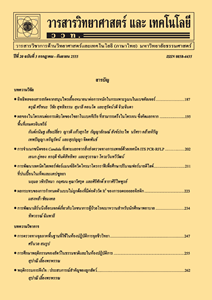การศึกษาการสร้างลมหมุนควงสว่านโดยใช้วิธีอีเล็กโตรไฮโดรไดนามิกส์เพื่อเพิ่มประสิทธิภาพการอบแห้งแบบใช้ลมร้อน
Main Article Content
Abstract
บทคัดย่อ
งานวิจัยนี้ศึกษาลักษณะลมหมุนวนแบบควงสว่านที่ถูกสร้างโดยผลของสนามไฟฟ้าเพื่อเพิ่มประสิทธิภาพของวิธีการอบแห้งแบบใช้ลมร้อน ลวดกราวด์จำนวน 2 เส้น ถูกวางในแนวขนานกับทิศการไหลของลมร้อน ส่วนตำแหน่งของลวดอีเล็กโตรดถูกวางตั้งฉากกับทิศทางการไหล โดยจำนวนลวดอีเล็กโตรดที่ใช้ทดสอบมีค่า n = 1 - 8 เส้น และตำแหน่งของปลายลวดอีเล็กโตรดซึ่งอ้างอิงกับตำแหน่งของผิวหน้าของวัสดุพรุนถูกทดสอบที่ระยะในทิศตั้งฉากการไหล Ly,E = 1 และ 3 cm และที่ระยะในแนวทิศการไหล Lx,E = 0 - 7.5 cm แรงดันไฟฟ้าที่ใช้ทดสอบมีค่า V = 20 kV อุณหภูมิและความเร็วเฉลี่ยของลมร้อนก่อนเข้าหน้าตัดทดสอบถูกควบคุมที่ 60 OC และ 0.35 m/s ตามลำดับ วัสดุพรุนถูกใช้แทนด้วยแพคเบดซึ่งประกอบด้วยน้ำ อากาศ และเม็ดแก้วขนาดเส้นผ่านศูนย์กลาง 0.125 mm แพคเบดมีค่าความอิ่มตัวเริ่มต้น Si = 0.5 ผลจากการทดลองพบว่าเมื่อปล่อยสนามไฟฟ้าสู่ลมร้อนทำให้เกิดลมหมุนในระนาบตั้งฉากกับการไหลบริเวณเหนือผิวหน้าของแพคเบด และด้วยอิทธิพลของลมหมุนวนทำให้แพคเบดมีอุณหภูมิและอัตราการระเหยของความชื้นออกจากวัสดุเพิ่มสูงขึ้น การเพิ่มจำนวนลวดอีเล็กโตรดทำให้อัตราการระเหยของความชื้นเพิ่มขึ้นประมาณ 1.2 - 1.7 เท่า การติดตั้งลวดอีเล็กโตรดที่ตำแหน่งลมร้อนเริ่มสัมผัสกับแพคเบด ให้ได้อัตราการอบแห้งสูง จากภาพถ่ายการไหลแสดงให้เห็นว่ารูปร่างและตำแหน่งของลมหมุนวนเปลี่ยนตามตำแหน่งของอีเล็กโตรดและกราวด์ การติดตั้งอีเล็กโตรดให้สูงกว่าตำแหน่งของกราวด์ส่งผลทำให้ลมที่ถูกเหนี่ยวนำโดยผลของการไหลแบบเฉือนมีทิศพุ่งลงสู่ผิวหน้าของแพคเบด ซึ่งทำให้เกิดการถ่ายเทความชื้นและความร้อนบริเวณผิวหน้าแพคเบดดีขึ้น
คำสำคัญ : ลมหมุนควงสว่าน; อีเล็กโตรไฮโดรไดนามิกส์; การอบแห้งด้วยลมร้อน; การเพิ่มการถ่ายเทมวลและความร้อน
Abstract
This research aims to study the patterns of electric-driven swirling flow for enhancing the efficiency of hot-air drying. Two ground wires are placed in the flow direction, while electrode wires are placed in the normal direction of flow. The number of electrode wires is tested at n = 1 - 8. In addition, electrode positions respected to the surface of porous material are varied both in the normal direction with Ly,E = 1 and 3 cm and in the flow direction with Lx,E = 0 - 7.5 cm. High electrical voltage is applied at V = 20 kV. The temperature and bulk mean velocity of hot air entering test section are controlled at 60OC and 0.35 m/s, respectively. In this study, a packed bed used as a porous material composes of water, air and 0.125-mm-diameter glass beads. The initial saturation of packed bed is Si = 0.5. It is found from experimental results when electric fields are exposed to hot-air flow, swirling flow is created in the plane normal to flow above the packed bed surface. With the influence of the swirling, surface temperature and the rate of moisture removal are rapidly increased. Increasing the number of electrodes enhanced the rate of moisture removal by 1.2-1.7 times. The maximum rate of moisture removal is obtained when the electrodes are placed in where hot-air flow initially attaches the surface of packed bed. It is shown from the flow visualization that pattern and location of the swirling depend on electrode and ground positions. When electrode position is higher than ground wires, air induced by shear flow effect impinges on packed bed surface, resulting enhancement of heat and mass transfer.
Keywords: spiral flow; electrohydrodynamics; hot-air drying; enhancement of heat and mass transfer


